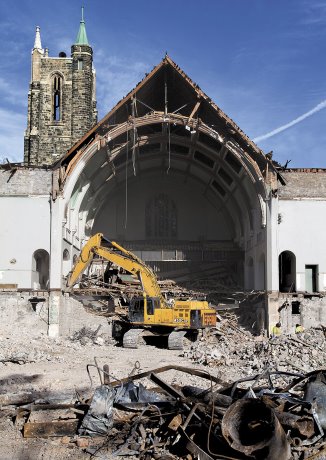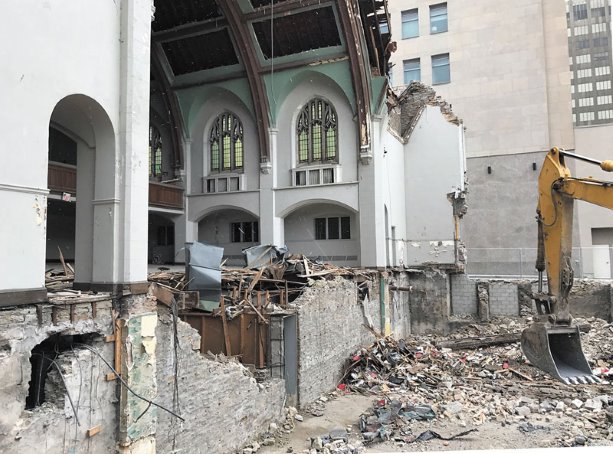Deer Park United Church has stood on the southeast corner of St. Clair Avenue West and Avenue Road since 1913. The property is currently being redeveloped by Camrost Felcorp into the 27-storey Blue Diamond condominium. Demolition contractor Teperman is responsible for preserving the heritage-designated portion of the church building through selective demolition.
Like many churches, the Deer Park congregation faced the costly challenges of maintaining a large legacy building. The one saving grace of the location — for years, next-door-neighbour Imperial Oil had supplied heat to the church at no cost. That agreement ended in July 2008 after Imperial Oil moved its head offices to Calgary. The building was subsequently desanctified, and the property sold to Diamond Corp., as the congregation merged with that of a nearby church.
Diamond Schmitt Architects is designing the development, which will incorporate the condo tower, street-level townhouses, a public courtyard and restaurant-retail features. ERA Architects Inc. is the project’s heritage architect.
ERA principal Andrew Pruss says his firm has been involved with the project since 2009.
"We worked with Diamond Corp as it initially took the project through the approval process to the ultimate decision by the city to approve a significant modification to the church," he says. "We advised on strategy, wrote the heritage impact assessment and the detailed conservation plan. We’re currently doing site review as the project moves forward. There was a lot of discussion among stakeholders about the right approach and we finally agreed on a final configuration."
The building plan preserves the front face of the church and the two walls extending southward. While the roofline will be preserved, only a section of roofing will be maintained near the front of the building, allowing most of the congregational seating area (the nave) to be converted into a publicly accessible open courtyard. The aisle on the east side of the church will be glassed in and, together with the front of the building, provide retail or restaurant space. The west aisle will remain open and provide courtyard access to pedestrians.
"On one hand, demolition is a planned and calculated process," says Pruss.
"On the other hand it can be fairly rough business. We helped establish a pre-cut line where you can do rough demolition to a certain point. From there you need to physically cut and remove the remainder of the demolished portion so you don’t have an impact on what’s remaining."
Sean Teperman, CEO of Teperman, notes that the church roof employs relatively light steel trusses over a large span.
"After abatement, our next step was to remove the existing interior ceiling so that we could reduce the load on the roof, exposing the trusses from beneath," he says. "From there we went on to remove the classrooms, auditorium and basement levels."
By early April, rough demolition had been completed. Stripping away the roof is a more complex task.
"The roof braces the walls, so you can’t take the roof off until you replace that bracing," says Pruss.
"The structural engineer, Jablonsky, Ast and Partners, designed a temporary bracing to support those walls so we can carefully remove more of the roof over the courtyard."
Teperman says that this task will be completed with a 100-foot CAT high-reach, carefully grappling the roofing material up and over the building.
Demolition crews will also have to cross what Teperman calls "the magic line" inside the preserved portion of the church. Careful handwork will include removal of part of the wall of the transept — the front part of the church that forms a cross when viewed from above.
"We’re going to be at it for a few more weeks, pending approvals from the city’s historical preservation services on each step of the demolition," he says.
"Then it will be time for the shoring rigs to begin their work on the new condominium."

1/2
Demolition contractor Teperman is responsible for preserving the heritage-designated portion of Deer Park United Church. The front facing portion of the church and its two walls extending southward will be preserved and incorporated into the new development.
Photo: WILLIAM CONWAY/PROGRESS PHOTOGRAPHY
2/2
Diamond Schmitt Architects is designing the development being built on the Deer Park United Church grounds




Recent Comments
comments for this post are closed